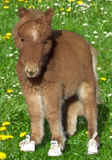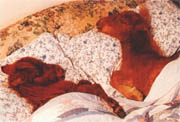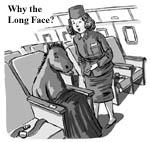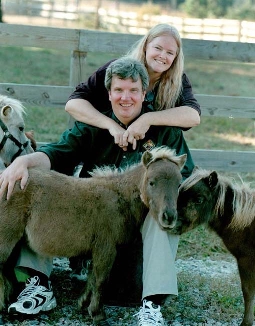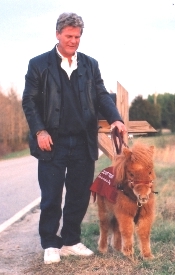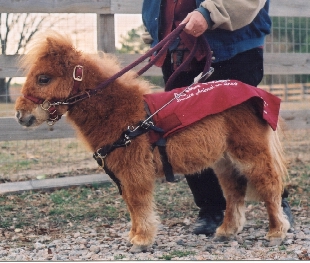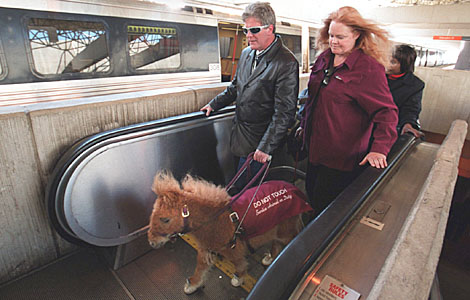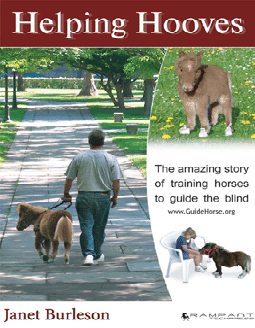|
|
Shaw is anxiously counting the hours until March 6, when he will fly south to meet Cuddles. “I know she’ll be part of the family,” he said with a broad smile. The Burlesons have sent Shaw a dozen photos — including a snapshot of the tiny horse reclining in Santa’s lap last Christmas. Cuddles has a distinct personality, they say. “She’s smart as a whip, and very headstrong,” Don Burleson said. “And it doesn’t hurt that Cuddles is extremely cute.” Shaw already carries a well-worn photo of Cuddles in his wallet, ready to whip out so he can show her off to family and friends. He talks about the mare as though she were a favorite grandchild. And because of Cuddles, he talks about his blindness for the first time in his life. “I think the hardest part was when I knocked down little children. I didn’t even see them,” Shaw said. Onlookers would jump to the conclusion that the silent man was drunk or drugged, and they spit out vicious comments about his behavior. Those hasty slurs hit Shaw harder than any of the misplaced chairs or half-open doors that have bespeckled his shins with scars. “I’d come up with excuses not to go out to bars with my friends. I’d take a girl out and get shot down because she thought I was drunk,” Shaw said. Shaw owns a white tipped cane. He points it out, gathering dust with some fishing equipment on the wall of his shop. But he can’t recall when he last used it. It was a clear signal of what Shaw didn’t want the world to see. “A blind person’s options were holding somebody’s arm, using a white cane, or having a dog — I didn’t like those options,” he said. For several months after his diagnosis, Shaw pondered his inevitable blindness in secret, keeping it from his mother so she wouldn’t have to face the fact that all three of her sons inherited the same disease. He learned to rely on sound and touch to enhance his limited sight, and few suspected that the man who deftly used power tools to build a deck at his home couldn’t see. But within the past five years, Shaw’s vision has decreased to 1 percent capacity. “It’s like sitting in a black box, looking through a pinhole,” said Shaw. The hole dwindled, and today, what little he sees is shrouded by a murky, spotted film. “I hurt myself daily. Every day I have some minor accident because of my own stubbornness,” Shaw said, nursing a sprained shoulder he incurred while splitting wood. Lately, he’s chosen to stay at home, where he knows the layout of his house and the bait shop he runs from his garage. Last winter, his wife, Ann, nearly convinced him to get a guide dog despite his worry about the grief of losing his guide after a decade of partnership. “It really breaks my heart to love an animal for 10 years of your life, then have to get a new one,” he said. Then the Shaws watched the Burlesons and their tiny horse, Twinkie, demonstrating the potential of pygmy guide horses on an episode of “Ripley’s Believe It Or Not.” Shaw immediately knew the horses, which can live as long as 40 years, were the option he had been awaiting. “I know that if there’s another blind person out there who feels like me inside, they’re just waiting for a guide horse,” Shaw said. “It’s like a dream come true — I feel like I’ve been blessed.” The Burlesons were inspired to attempt to train their pet Twinkie as a guide animal while riding through New York City on horseback. “I was mortified being on horseback in Manhattan. There were cars whipping all over,” Burleson said in an interview. “That horse pretty much guided me through the most chaotic traffic in America — I was just a passenger on that ride.” From the Old West silver screen drunk who stumbled onto his mount and awoke at home, to the cab horses that knew the names of New York’s finest 19th century hotels, or the animals that carried wounded soldiers from Civil War battlefields, horses have been guiding humans for centuries, Burleson said. Don, an animal behavior specialist, and Janet, a professional horse trainer, wondered: “If big horses, why not little horses?” “Training a horse, whether 50 pounds or 1,200 pounds, is the same,” he said. Within a few months, the Burlesons put Twinkie through a combination of the training that police horses receive so they can calmly patrol riots and the training that transforms dogs into personal guides. The horses can accomplish everything their canine companions do — they can be housebroken, trained to paw at the door when they need to go outside. And pygmy horses offer some distinctive qualities that make them perfect guide animals, Burleson said. As prey animals, horses are born with a powerful memory that keeps the herd safe. A horse can travel a route once and remember it years later. Horses of any size can see nearly 360 degrees: everything but their tail. “A horse always errs on the side of caution,” Burleson said. Like toy poodles, pygmy horses have been created through centuries of selective breeding. A French pygmy horse roamed the Versailles gardens during the reign of Louis XIV. And tiny Welsh horses toiled in narrow 19th century coal mines. Their temperament, intelligence and stamina are identical to that of their larger cousins. “They will go for miles at a trot and not break a sweat,” Burleson said. Although the size of pygmies ranges widely, animals selected for guide horses must measure between 20 and 25 inches at the shoulder — any smaller and the animals become too rare and costly; larger and they won’t fit under restaurant tables, Burleson explained. Wealthy donors have given 10 animals to the Guide Horse Foundation so it may offer the trained animals at no cost to their human partners. In March, Dan will fly to North Carolina and learn how to use the 20 voice commands and countless body signals Cuddles uses to communicate. Cuddles already has spent nearly a year learning to view her partner as an extension of her own body, and how to face frightening situations such as escalators and subways. “The get-down-and-dirty serious training will begin in May,” Burleson said. “It’s kind of like teaching Dan how to drive a car.” Finally, in early June, Shaw will bring Cuddles home for a week’s training that will acclimate his guide to her new daily routine. Ten animals are going through the guide training process. Two of Cuddles’ fellow trainees will be sent to homes in Oklahoma and Washington in the next year, Burleson said. According to a recent online survey conducted by the Discovery Channel, 27 percent of respondents would choose a guide horse over a dog. “Given that there’s a million blind people in America, that’s a lot of demand,” Burleson said. Already, more than 30 blind adults have asked to be placed on a waiting list at the Guide Horse Foundation. Burleson expects the demand to rise. Rather than supplant guide dogs, pygmy horses will broaden the options available to a blind person, he said. “It isn’t for everybody,” Shaw said. He has the rural backyard necessary to keep an off-duty pygmy horse happy. But in her tiny sneakers, worn to give her traction on slippery floors and protect delicate hooves too small for iron horse shoes, Cuddles has proved irresistible to media worldwide. Shaw has done so many interviews with reporters scattered from New York to Tokyo, that he can’t even remember them all. Time magazine and NBC’s “Today” show recently came calling. All of the major American television networks will be on hand when Shaw and Cuddles make history with their first commercial flight together in March. Shaw plans to spend the first few months of his partnership with Cuddles traveling the United States to make media appearances. But Shaw said his biggest reward will come in May when the bright lights subside and he can take Cuddles out for a long ramble beyond his familiar house and yard, the kind of walk he’s been unable to make for several years now. “That’s what I’m looking forward to most, that freedom of independence,” Shaw said. For information, contact the Guide Horse Foundation at (252) 433-4755 or info@guidehorse.com
|
Guides Training Press Photos News Apply FAQ Wishes Contact Home
|
|
Copyright © 1998 - 2005 by the Guide Horse Foundation Inc. Guide Horse ® Guidehorse ® and Helping Hooves ® are registered trademarks. |
The Guide Horse Foundation has the utmost respect for The Seeing Eye® and their seventy-two years of outstanding work with assistance animals for the blind. Even though the press often calls our horses "seeing eye horses", please note that The Guide Horse Foundation is not affiliated with or sanctioned by the Seeing-Eye® or any of the Guide Dog training organizations. Seeing-Eye® is a registered trademark of the Seeing-Eye, Inc.
